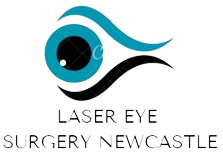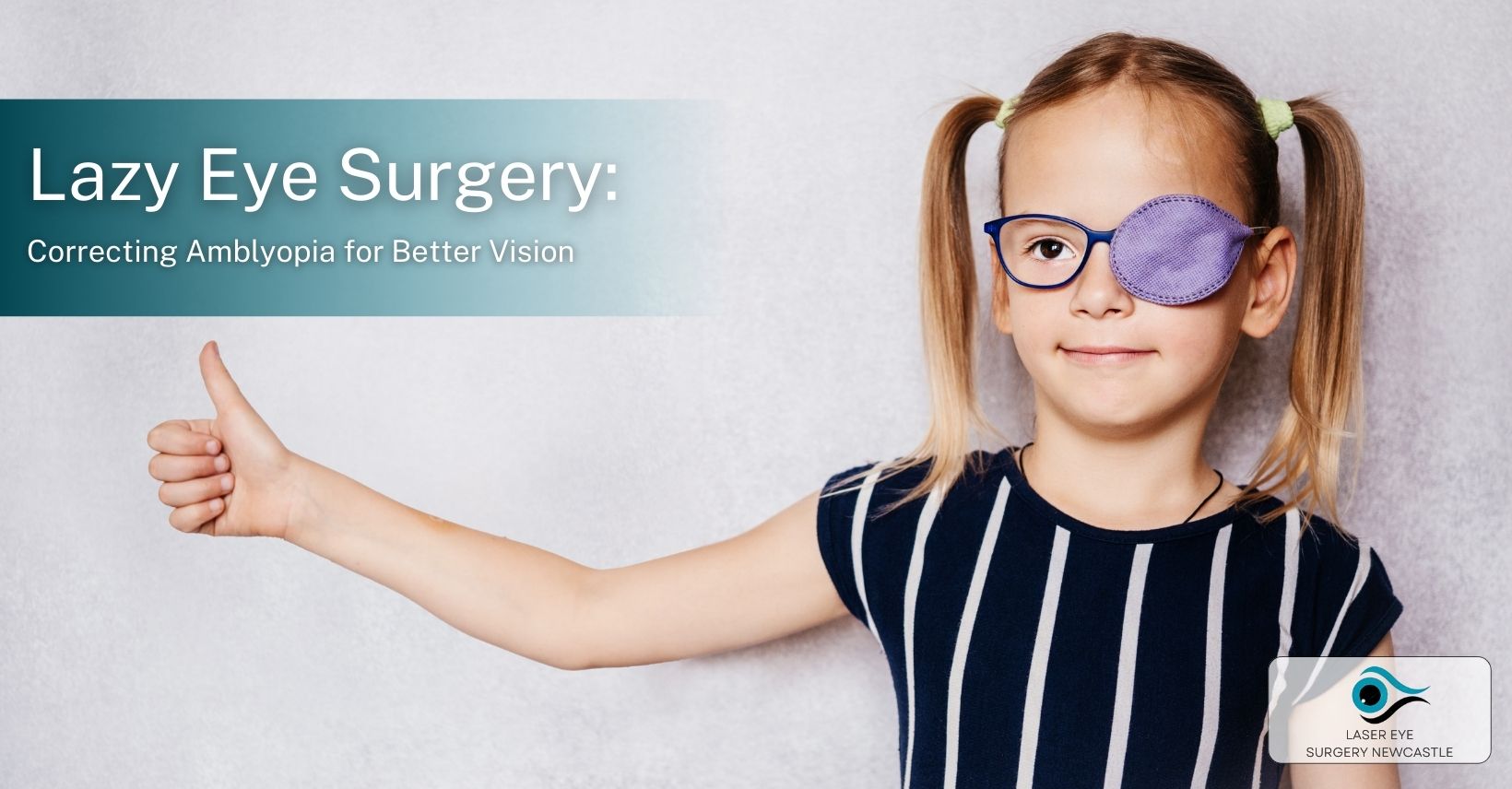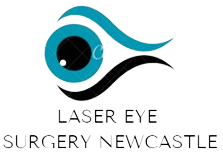Amblyopia, commonly known as lazy eye, is a condition that affects vision and can lead to poor depth perception and other visual impairments.
In this article, we will explore the causes, symptoms, diagnosis, and treatment options for amblyopia, including patching therapy, atropine drops, corrective eyewear, and vision therapy.
We will also discuss when lazy eye surgery may be recommended for amblyopia and what to expect during the procedure. If you are considering laser eye surgery in Newcastle, we will guide you through the process and help you on your path to better vision.
What is Amblyopia (Lazy Eye)?
Amblyopia, often referred to as “lazy eye,” occurs when one eye does not develop normal vision and remains blurry even with corrective eyewear. This condition predominantly affects children, disrupting their vision development during critical early years.
In cases of amblyopia, the brain tends to rely on the stronger eye, leading to reduced functionality in the weaker eye. Such imbalance prevents the visual cortex from maturing properly, impairing depth perception and hindering motor coordination.
Recognizing and treating amblyopia early is vital to prevent lasting vision problems. Ideally, before a child turns five, regular vision screenings play a key role in the timely identification and management of this disorder.
Treatments may include:
- Wearing an eye patch on the stronger eye stimulates the weaker one.
- Applying eye drops.
- Using corrective lenses to balance vision.
As we examine how amblyopia affects visual development, it’s natural to question the underlying causes of this condition, which can range from genetic predispositions to environmental factors.
What are the Causes of Amblyopia?
Understanding the causes of Amblyopia, such as Squint (crossed eyes), Anisometropia (unequal refractive error), and conditions like Cataracts that lead to deprivation, is the first step in taking proactive measures for your vision health.
Strabismus (Crossed Eyes)
Strabismus, commonly known as crossed eyes, is a condition in which the eyes do not properly align when looking at an object. It often leads to Amblyopia.
Strabismus can impact a person’s depth perception and eye coordination due to the misalignment of the eyes. This misalignment can cause the brain to favour one eye over the other, leading to Amblyopia.
There are several types of Strabismus, including esotropia (inward turning of the eye), exotropia (outward turning of the eye), hypertropia (upward turning of the eye), and hypotropia (downward turning of the eye).
Each type can affect vision development differently and may require different treatment approaches. Detecting and addressing Strabismus early is important to prevent long-term impacts on vision health.
Anisometropia (Unequal Refractive Error)
Anisometropia occurs when there is a considerable difference in the refractive power of each eye, causing one eye to be more focused than the other, which can lead to Amblyopia.
When Anisometropia is present, the brain often starts to favour the eye with clearer vision, while gradually suppressing the signals from the weaker eye. This can lead to Amblyopia, commonly known as lazy eye, and greatly impacts depth perception, coordination, and overall visual function.
However, with early detection and the right corrective measures such as glasses, contact lenses, or vision therapy, there is hope for both eyes to work together properly.
Deprivation (Cloudy Eye)
Deprivation amblyopia develops when a physical blockage, like cataracts, clouds an eye and restricts clear vision. During early childhood, a critical time for visual development, an eye with blurred vision sends incomplete images to the brain.
The brain, favouring input from the unobstructed eye, might disregard the blurry images from the affected eye, worsening the condition. Early detection and treatment of cataracts are essential to prevent permanent visual impairment.
Analysing related symptoms is useful to ensure timely intervention regarding how deprivation amblyopia impacts vision development.
What are the Symptoms of Amblyopia?
The symptoms of Amblyopia can vary but typically include poor depth perception, frequent squinting or closing of one eye, and noticeable head tilting or turning to compensate for vision issues.
Poor Depth Perception
One of the hallmark symptoms of Amblyopia is poor depth perception, which can make judging distances and spatial relationships difficult.
Individuals with this condition may need help with tasks such as catching a ball in sports, pouring liquid without spilling, or navigating busy environments.
For instance, poor depth perception can make activities like driving more hazardous, as judging the distance between vehicles or objects becomes more difficult.
Addressing poor depth perception, a key symptom of Amblyopia is required. Doing so can greatly improve quality of life and help prevent potential accidents or mishaps.
Squinting or Closing One Eye
People with Amblyopia often squint or close one eye to improve their vision and compensate for the reduced visual acuity in the affected eye.
This behaviour helps to reduce the input from the weaker eye, allowing the brain to rely more on the signals from the stronger eye, thus enhancing visual perception. By blocking the impaired eye, individuals with Amblyopia can often achieve better depth perception and focus.
This method of visual compensation is an instinct to adapt to the condition, as the brain prioritises the stronger visual input for improved overall vision. Squinting or closing one eye also aids in reducing double vision and enhancing visual clarity by eliminating conflicting signals from both eyes.
Head Tilting or Turning
Head tilting or turning often signals amblyopia as individuals adjust their posture to use their stronger eyes more effectively. This adjustment helps them see objects more clearly, enhancing depth perception and clarity.
However, this continuous compensation can lead to neck and shoulder discomfort as the muscles adapt to an unnatural position. Such discomfort might interfere with routine activities like driving or reading, diminishing the overall quality of life for those affected. As we examine further, comprehending how professionals identify this condition will shed light on the necessary steps to diagnose amblyopia effectively
How is Amblyopia Diagnosed?
Comprehensive eye examinations are pivotal in diagnosing amblyopia. They focus on critical factors such as visual acuity, eye alignment, and other revealing symptoms. The visual acuity test is essential, independently measuring the clarity of vision in each eye.
Also, tests like the cover test and the corneal light reflex test play roles in detecting misalignment, commonly called squint. Detecting amblyopia early is vital to enable timely interventions.
Options like patching therapy or vision therapy enhance visual capabilities and avert long-term vision impairments. As we continue to analyse eye health, comprehending the treatment strategies for amblyopia provides a natural segue into examining effective remedies and innovative therapies designed to correct this vision anomaly.
How is Amblyopia Treated?
Treatment for Amblyopia typically involves occlusion therapy, atropine eye drops, corrective eyewear such as spectacles, and specialised vision therapy exercises to enhance visual acuity in the affected eye.
Patching Therapy
Patching therapy involves placing an eye patch over the stronger eye to force the weaker eye to work harder and improve its visual acuity.
This type of therapy is commonly used to treat conditions like Amblyopia, also known as lazy eye. The brain is compelled to rely more on the weaker eye by covering the stronger eye, helping it develop better vision.
The duration of patching therapy can vary depending on the severity of the condition, ranging from a few hours a day to wearing the patch for most of the waking hours.
It is essential for patients undergoing patching therapy to follow the recommended schedule diligently to maximise its effectiveness. Through consistent patching, many individuals have experienced significant improvements in their visual function and binocular vision.
Atropine Drops
Atropine drops are used as an alternative to plastering. Drops are placed in the stronger eye to temporarily blur its vision, compelling the weaker eye to work harder.
This treatment method is particularly effective in cases where plastering may be challenging, such as in younger children who may resist wearing an eye patch. By using Atropine drops, the visual acuity of the weaker eye can be improved over time through consistent use.
Like any medication, Atropine drops may also come with potential side effects. Some common side effects include sensitivity to light, blurred vision, and eye irritation. It’s important to consult an eye care professional before starting Atropine treatment to ensure it is the right option for treating Amblyopia.
Corrective Eyewear
Corrective eyewear, such as spectacles, can help address refractive errors and improve vision in individuals with Amblyopia.
Amblyopia, commonly known as lazy eye, is a condition that affects visual development, often in childhood. The brain can start to interpret visual signals more effectively through corrective eyewear, correcting lazy eyes. Improvements in visual acuity can be achieved with the right prescription, which may include:
- eyeglasses
- contact lenses
- prism glasses
Each type of prescription serves a unique purpose in managing Amblyopia and has shown varying degrees of effectiveness based on individual needs.
Vision Therapy
Vision therapy employs targeted exercises to enhance eye coordination and function, directly addressing Amblyopia. These exercises include focusing on various distances, tracking movements, coordinating both eyes, strengthening eye muscles, and improving visual processing.
Regular practice can improve depth perception, alignment, and overall visual acuity. The method boosts patient confidence as patients see improvements in their vision, often complementing other Amblyopia treatments like patching or corrective lenses.
This comprehensive approach not only corrects visual imbalances but also fosters a sense of accomplishment in patients. Considering these therapies, assessing when surgical interventions might be necessary becomes pertinent, especially in cases where non-surgical methods have reached their limits.
When is Surgery Recommended for Amblyopia?
Surgical intervention is often the next step for treating Amblyopia when traditional treatments like patching, atropine drops, and vision therapy prove ineffective.
This procedure, typically conducted by an ophthalmic surgeon, includes surgery to realign eye muscles to enhance vision coordination. In cases where cataracts severely impair vision, cataract surgery becomes essential.
These operations rely on ophthalmic surgeons’ precise skills and thorough training, ensuring successful outcomes in these sensitive eye surgeries.
As we examine these interventions, comprehending the specific processes involved in Amblyopia surgery will shed light on what patients can expect during these delicate procedures.
What Happens During Amblyopia Surgery?
Amblyopia surgery involves various procedures aimed at correcting the underlying causes of the condition, such as Squint surgery, cataract removal, or corneal transplants, all performed by a skilled ophthalmic surgeon.
Strabismus Surgery
Squint surgery aims to correct eye misalignment, commonly known as crossed eyes, by adjusting the muscles that control eye movement.
This surgical procedure involves repositioning the eye muscles to improve eye alignment and correct the underlying issue that causes the misalignment.
During the surgery, the ophthalmologist carefully targets specific eye muscles to enhance eye coordination.
The effectiveness of Squint surgery varies from person to person. While it can greatly improve eye alignment and visual function, complete correction may only sometimes be achievable.
Cataract Surgery
Cataract surgery involves removing the eye’s cloudy lens and replacing it with a clear artificial lens to restore vision and treat deprivation Amblyopia.
During the procedure, the surgeon makes a small incision in the eye to access the clouded lens. The cloudy lens is broken up using ultrasound waves and removed from the eye. Once the cloudy lens is removed, an intraocular lens is inserted. This artificial lens helps to focus light properly onto the retina, improving vision.
After cataract surgery, patients may experience some temporary discomfort and blurry vision. The recovery process involves using prescribed eye drops to prevent infection and aid healing. Attending follow-up appointments is important to monitor progress and ensure optimal healing.
Many individuals notice a significant improvement in their vision following cataract surgery, with colours appearing more vivid and objects sharper. This surgery can be life-changing for some, enabling them to regain independence and enjoy a better quality of life.
Corneal Transplant
A corneal transplant is a surgical procedure where a damaged or diseased cornea is replaced with a healthy donor cornea to improve vision in cases of severe Amblyopia.
Indications for a corneal transplant may include conditions such as Keratoconus, corneal scarring, or corneal degeneration that cannot be corrected with other treatments.
The surgical procedure involves removing the damaged cornea and replacing it with a clear donor cornea, which is stitched into place. Following the surgery, patients with Amblyopia may experience improved vision, reduced eye discomfort, and enhanced quality of life.
It is important for patients to follow post-operative care instructions diligently to maximise the success of the transplant.
Why Choose Laser Eye Surgery Newcastle for Your Lazy Eye?
Choosing Laser Eye Surgery in Newcastle, offers patients access to advanced surgical techniques, comprehensive consultations, and high-quality care from experienced ophthalmic surgeons.
Book Your Reservation Now
Scheduling your consultation with Laser Eye Surgery in Newcastle is a pivotal first step toward enhanced vision, featuring expert healthcare and individualised treatment plans.
This streamlined process allows you to quickly secure an appointment by calling their dedicated line or using the user-friendly online form on their website. The welcoming team at Laser Eye Surgery in Newcastle will help you find a time that works best for you.
At your appointment, seasoned professionals will assess your vision thoroughly. They’ll examine your medical history, discuss current eye conditions, and outline your treatment goals.
Remember to bring any relevant medical documents, a list of medications, and your insurance details to ensure a comprehensive consultation.
As you consider the benefits of laser eye surgery, our next discussion will naturally extend into other vision correction procedures. We’ll explore additional insights that could further enhance your journey to achieving the ultimate goal of clearer, more effective eyesight.
Your Path to Better Vision: Wrapping Up Lazy Eye Surgery Insights
Comprehending the various aspects of diagnosing and treating Amblyopia, or Lazy Eye, is essential for ensuring effective management and improved vision. It highlights the importance of early intervention, appropriate treatment options, and adherence to regulatory obligations in healthcare services.
Regular eye examinations are key to the early detection of Amblyopia, which can greatly impact a patient’s visual outcomes. Healthcare providers must educate parents and patients about the condition and the importance of these examinations and provide customised treatment plans.
Timely intervention enhances the chances of successful recovery and prevents potential complications. Adherence to established standards ensures patients receive the highest quality care, promoting better prognosis and long-term visual health.
Therefore, healthcare professionals play a pivotal role in the early identification and management of Amblyopia to achieve optimal results.






